This is what climate change and transphobia have in common, according to non-binary author Dr Meg-John Barker
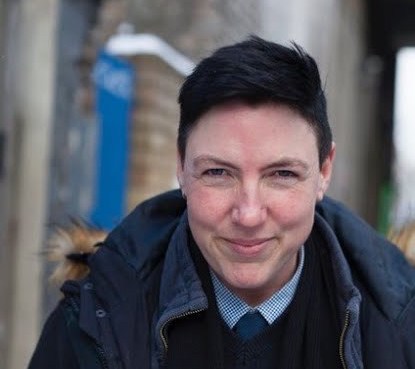
Dr Meg-John Barker. (Fox Fisher)
Dr Meg-John Barker. (Fox Fisher)
Dr Meg-John Barker, a non-binary relationships educator and author of Life Isn’t Binary, Rewriting the Rules and now Gender: A Graphic Guide, talks to PinkNews about gender, feminism, climate change and, of course, gay animals.
This interview has been edited for clarity and length.
PinkNews: The book immediately gets you thinking about all of the different ways we experience gender, and how important context is – for example, other facets of identity like race or class and how they shape the way you experience gender and the way gender is imposed on you. What do you think the world would be like if everyone thought, or was open to thinking, about gender this expansively?
Dr Meg-John Barker: The whole way through the book, I was trying to hold this tension: we’ve had this really restrictive gender system and, although it’s operated in somewhat different ways in different times and places, it pretty much always has been this kind of patriarchal system, so to what extent is it even possible to get away from that? But, at the same time, there has been this diversity in how people have experienced their gender, so clearly it is possible to experience gender differently and to have different understandings of it.
I think it’s about wanting to liberate everybody. I think that’s something that a lot of the trans activists I include in the book, like Travis Alabanza and Juno Roche, are saying. It’s like, can we liberate everybody from these restrictive gender roles? So it’s not just about creating a safer space for trans and non-binary people, but much more about really recognising how this gender stuff has kept so many people in such painful positions their whole lives.
Like how bad it is for kids of all genders, in terms of the bullying they receive; how bad it is for men in terms of suicide rates and criminalisation; how bad it is for women in terms of body issues and depression and feeling like they just have to be for others.
We can’t look at the gender piece without looking at the race piece or the class piece.
So, I think it would be genuinely liberating but, like you say, because it intersects with all these other things, we kind of can’t look at the gender piece without looking at the race piece and the class piece, you know… It’s not like you can pick out gender and dismantle that bit without also addressing problems in capitalism or in climate crisis or in white supremacy.
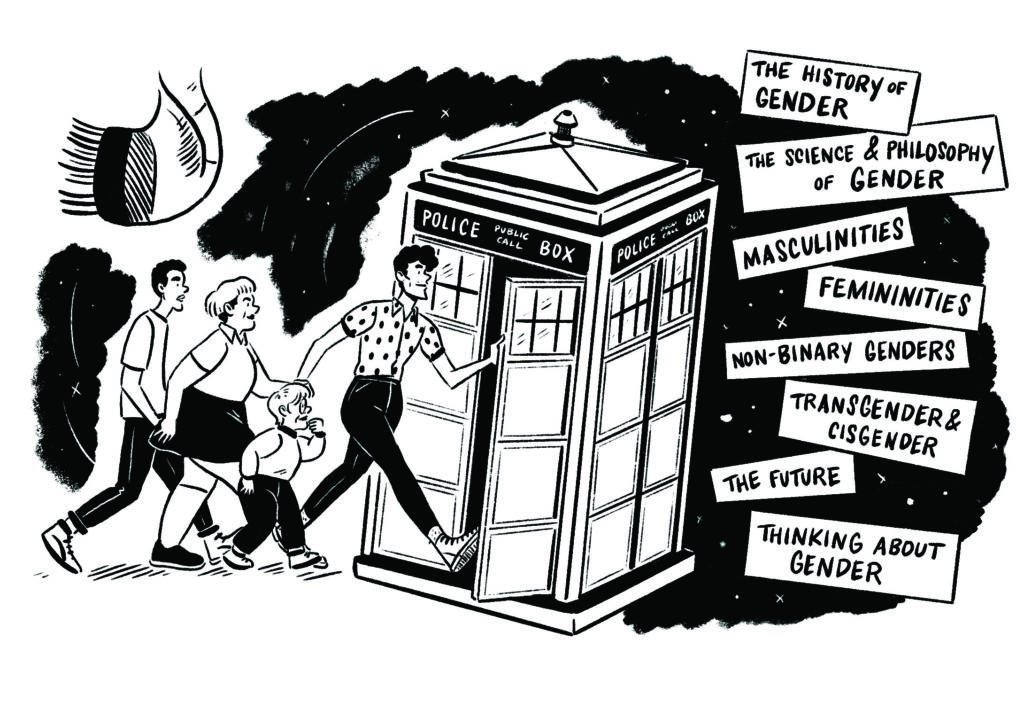
The themes covered in Gender: A Graphic Guide. (Jules Scheele)
Don’t worry, we’re going to get to the climate crisis in a bit.
Sometimes, I get really sick of gender and am like, ‘Does it even exist? F**k this!’. I report on a lot of trans stuff, and I think that’s where that feeling sometimes comes from. I wondered if you ever feel like that? Gender is obviously really central to your work. Do you ever feel like, ‘F**k it!’? And what do you do when you feel like that?
It was interesting writing this book after the queer one [Queer: A Graphic History]. It was hard. It definitely felt hard to write and I think that Kiera [Jamison], who edited it, and Jules [Scheele], who illustrated it, also felt a bit of that. There was something about writing this right in the midst of #MeToo and the trans moral panic, things that were really live when we were writing it.
There was a sense of, ‘Ugh, I’m so done with this, it’s everywhere, in all of these things that are going on around us’. And just seeing these debates and fights playing out and some of the old double standards, and transphobia and misogyny, just continuing… It’s kind of jading.
I see and experience gender as a very playful space.
But I guess, again, I sort of see and experience gender as a very playful space. So many of the people I’m drawing on in the trans and non-binary chapters of the book are doing these incredible things with gender that are creative and liberating, and it can be really fun to play with once we get out of the restrictions of it, to some extent.
So, for me, experiencing more masculine and more feminine parts of myself at different times can feel really fun and playful and creative and fascinating. It’s this non-binary-ness through the whole thing of: ‘Yeah, I’m so done with gender, and it’s also this creative space, and it’s also gender doesn’t exist, and it’s also really important and very real in our lived experiences.’ You know? It’s a constant paradox.
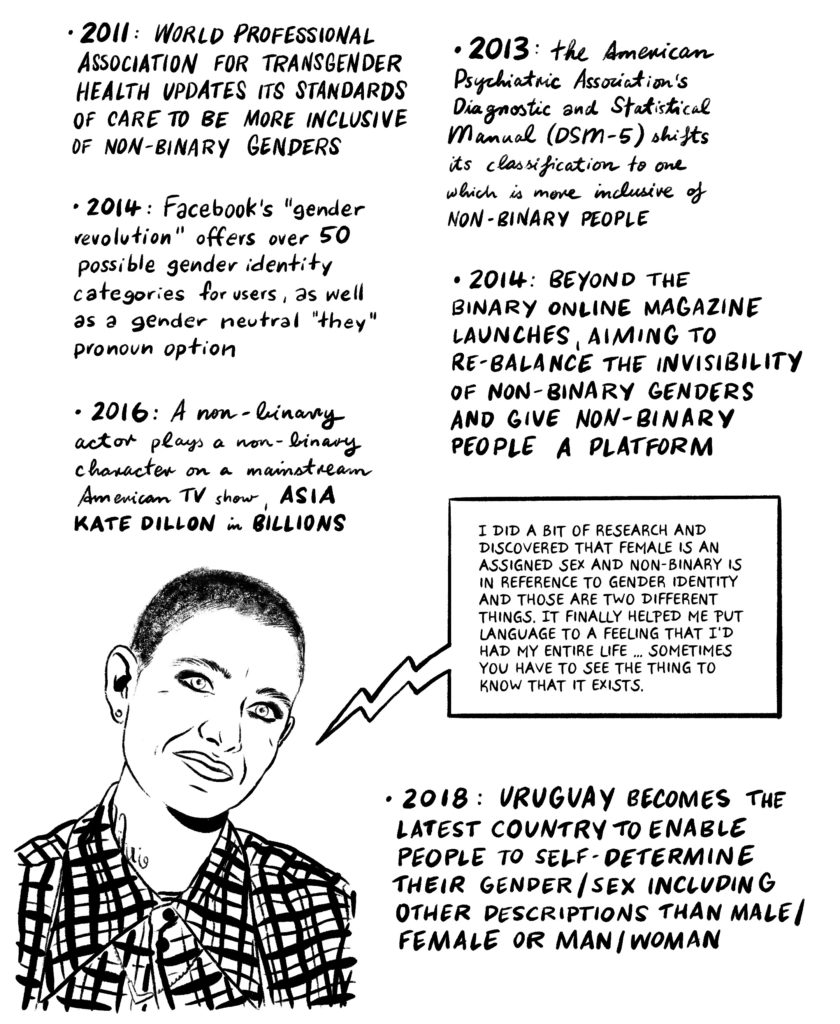
A brief history of the recent increase in visibility of non-binary people. (Jules Scheele/Gender: A Graphic Guide by Dr Meg-John Barker)
There’s only going to be one question on this, I promise. There are certain feminists –
[Laughter]
Who we can call anti-trans or “gender critical”, who think that trans rights come at the cost of women’s rights, in a nutshell. It’s really frustrating. Can you see a way through to a point where we’ll be able to reconcile the people arguing against trans rights with the people arguing for them?
It’s just so tragic. It feels so sad, because it feels like a lot of people who should be on the same side and should be doing this work together are then polarised, and again – with these two opposing sides – the binary feels like the real villain of the piece in a way.
The binary feels like the real villain of the piece.
Because sometimes, the things being said [by “gender-critical feminists”] do hint at complexity in how gender works, and we could all be really delving into that complexity and really looking at it. But instead, we have the polarisation into opposing views. And the media really whips that up. People have been writing in media studies for years now how the media likes to pit different feminists against each other, in the form of a catfight, and basically it’s another way of undermining women.
So, it fits into that broader… People see it as a new thing, but it’s actually something that’s always happened and it does patriarchy’s job for it really well, because everyone’s busy fighting each other rather than really looking at the gender system that needs dismantling for everybody.
When I do training sessions about this, and try to educate about it, I try and situate it as all of our battle. Absolutely everyone is being failed by this, it’s not serving a single person. And it’s definitely not serving women, including trans women, or trans men and non-binary people.
The media likes to pit different feminists against each other, in the form of a catfight, and basically it’s another way of undermining women.
I feel like if we could see it that way, and I also guess we have to get to the real pain and wounding that is underlying why people are getting so… yeah. Another piece of it is that another common strategy is getting people to look at the most marginalised people and blame them.
The broader theme is the more privileged and powerful folks kind of managing to get everyone looking at something else – it’s similar to migration, where British working-class people were told that immigrants were ‘taking their jobs’, so that becomes the battle, instead of it being about the wider system being at fault and looking at who benefits from that.
Instead of looking at the gender system and looking at who it benefits, we end up here.
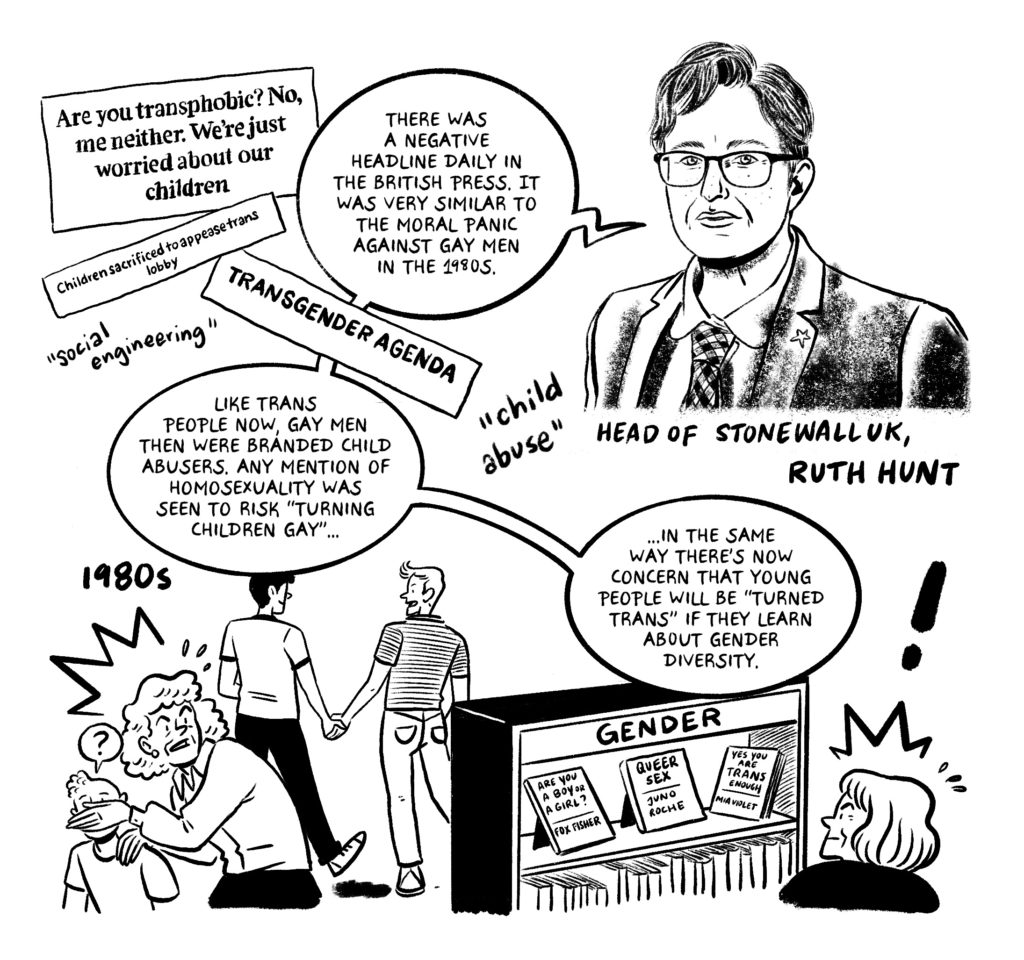
Parallels between 1980s homophobia and current transphobia. (Gender: A Graphic Guide by Dr Meg-John Barker/Jules Scheele)
The right-wing press got mad about a BBC video saying there are 100 genders. What I loved was that in those articles, the papers were saying, ‘100 genders is ridiculous! The Royal College of GP’s says there are six, how dare the BBC overrule it!’, when those journalists would usually be outraged at the idea of even six genders – anything more than two is usually a cause for mockery. Why do you think people feel so threatened by the idea that there are more than two genders?
There’s another kind of analogy with climate change stuff here – intergenerational trauma and justice.
Instead of feeling loss and grief it’s easier to say, ‘No, this is all made up’, instead.
It happens in families, but also in whole cultures. So, you get intergenerational tensions – within feminism, but also in general – saying, ‘You’ve hurt us with this, but there’s a different way of doing it.’ It goes back to Simone de Beauvoir and the way mothers and daughters pass down femininity. It’s the pain of the mothers, realising that their daughters can do femininity differently.
There’s a real sense that gender, and problematic gender norms, get passed on down the generations unless a generation reflects on them and shifts things. Instead of feeling loss and grief, which are so painful, it’s easier to say, ‘No, this is all made up,’ instead. It’s easier.
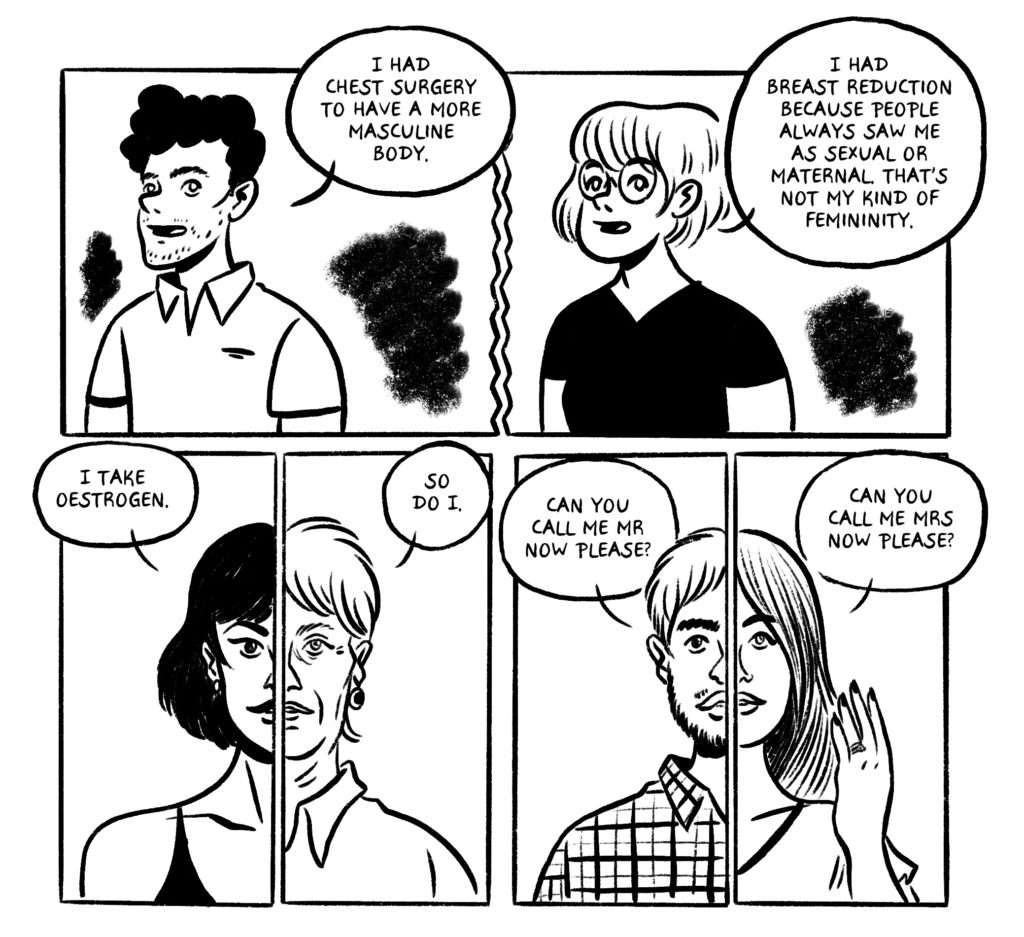
Gender is more expansive than people think – and not just for people who are transgender. (Gender: A Graphic Guide by Dr Meg-John Barker/Jules Scheele)
This is a good segue into climate stuff. I’m asking everyone this question at the moment, because all the queers I know are existing in a permanent state of eco-dread. Where are you at with climate stuff and how do you cope with it?
God, yeah. The climate crisis! It’s been a f**ker of a few years, for all of us and for queers particularly – especially trans people, with the increasing number of hate crimes, the trans moral panic, Brexit, Trump…
It all feels so interwoven to me alongside climate stuff.
It all feels so interwoven to me alongside climate stuff, where we see governments not caring because it’s impacting the global south so much more. Everything feels all tangled together – gender and climate etc – we just have to recognise now that there’s no way out of it, we kind of have to see it and see it all.
It can feel really big and hopeless. When do we go to self-care and stay safe enough? We have to recognise our limits. How can I weave this stuff through the writing I do, and make it accessible to people? It’s really hard. Communities of support are vital.
I like to write stories about gay animals to take my mind off the hard stuff. Does Dr Meg-John Barker have a favourite gay animal, and do you have a similar strategy you could share?
Yes, it’s vital to have playful strategies! Especially if there’s a version of what you do for your serious work that you can go to for silly stuff. I like writing erotic fan fiction – like, Harry Potter meets Buffy the Vampire Slayer-themed erotic writing.
Long-eared hedgehogs are my favourite gay animal.
And, long-eared hedgehogs are my favourite gay animal. The female ones are lesbians, I’m pretty sure. [Dr Meg-John Barker is right – according to the Telegraph, 10 per cent of female long-eared hedgehogs have sex with other females, and apparently the lesbian sex – which includes oral – is “surprisingly sophisticated“.]
You can buy Gender: A Graphic Guide by Dr Meg-John Barker here.

